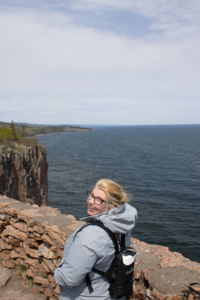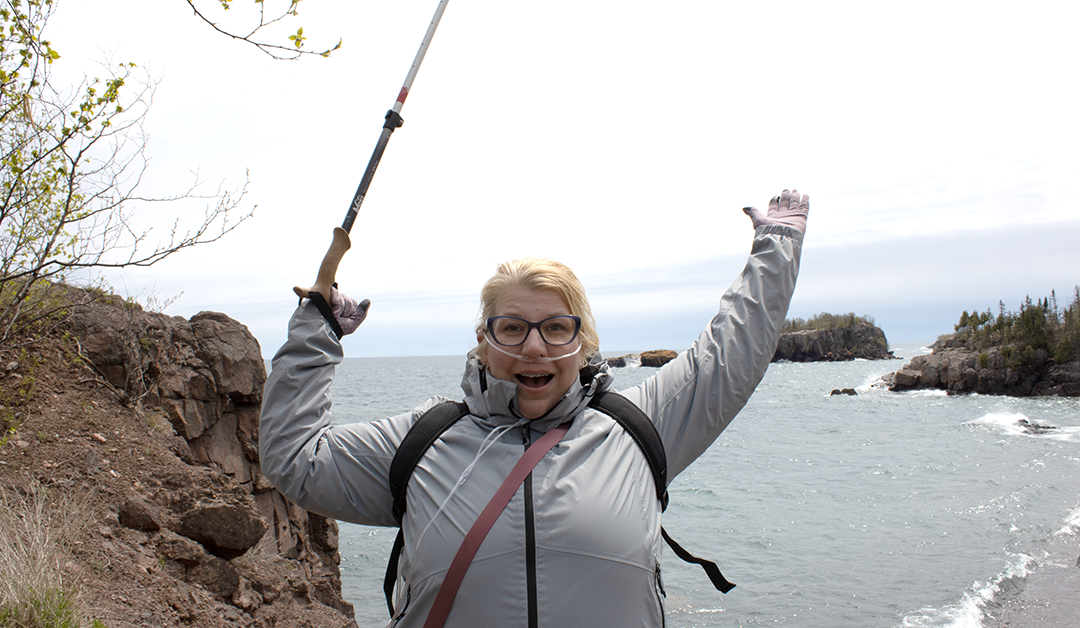Contributed by Natalie Haglund, consultant to CAIRE Inc.~
So, now what? Almost two years in, living with an interstitial lung disease, I was asking myself this question. I was working full time and doing everything I could to stabilize and manage an unpredictable lung disease. Hobbies and activities had gone to the wayside. When visiting with friends and family they always had stories and memories to share with me about what they’ve been doing and the places they’ve been. I wanted to share too, but I didn’t have much to talk about. I felt like I was losing my identity. My lung disease was becoming my identity. That didn’t sit well with me, so I made the decision to do something about it.
So, now what? I’ve always enjoyed creative projects, so I decided to start there. At that time, I was physically limited and exhausted much of the time, what I chose had to be manageable. Things like scrapbooking, fairy gardens, paint and sip events, ensued. There was the occasional concert, boat ride with friends, and occasional motorcycle ride. However, I missed being physically active. I wanted to run, to swim, to roller skate. I wanted my body to work like a healthy, active person’s body. I saw my friends doing fun, cool, amazing things and I wanted to do that too. A pulmonary rehab program started where I work. That intrigued me. It wasn’t the physical activity I dreamt of, but it was something. I quickly got a referral from my doctor, signed up, and completed the program in four months.
So, now what? I needed something to keep me moving. I decided to sign up for a 5K. This was a thought-out process which I’ll tell you about in my next blog. The training I’ve done has been primarily on a treadmill. This works well; however, I wanted to walk outdoors. The road I live on isn’t always ideal, so that wasn’t the best option. I realized, there are an abundance of state parks and trails where I live. Over the past several years I’ve been hiking and exploring these areas.
 I used to think of a hiker only as someone who backpacks a great distance, or someone who makes their way to the top of a mountain. Over the past few years, I’ve realized that it’s all relative. I am a hiker. Am I summiting a 14-er in Colorado? For those of you who don’t know, a 14er, or fourteener, is a fancy term for a mountain with an elevation that exceeds an elevation of 14,000 feet above sea level. For me the answer is definitely, “No.” Elevation and lung disease don’t play well together. Am I choosing manageable trails with beautiful scenery? Yes! I love being surrounded by a big green forest, looking out at a beautiful blue lake, admiring the power of a waterfall, taking deep breaths of fresh air. I also love to capture these views “on film.” For a long time, I used my cell phone. Last year I decided to learn more about photography and purchased a camera. Nature and sightseeing photography have been my favorite so far, and that pairs well with hiking. A win-win!
I used to think of a hiker only as someone who backpacks a great distance, or someone who makes their way to the top of a mountain. Over the past few years, I’ve realized that it’s all relative. I am a hiker. Am I summiting a 14-er in Colorado? For those of you who don’t know, a 14er, or fourteener, is a fancy term for a mountain with an elevation that exceeds an elevation of 14,000 feet above sea level. For me the answer is definitely, “No.” Elevation and lung disease don’t play well together. Am I choosing manageable trails with beautiful scenery? Yes! I love being surrounded by a big green forest, looking out at a beautiful blue lake, admiring the power of a waterfall, taking deep breaths of fresh air. I also love to capture these views “on film.” For a long time, I used my cell phone. Last year I decided to learn more about photography and purchased a camera. Nature and sightseeing photography have been my favorite so far, and that pairs well with hiking. A win-win!
My most recent adventure was up the North Shore of Lake Superior in Minnesota with my daughter. We set out on our road trip with a flexible agenda, with ideas of where we wanted to stop and explore. Weather on the first day of our road trip was cold and very windy, especially by the big lake. Some of our stops were cut short because of this, but we still were able to enjoy some amazing scenery. My favorite stop that day was at Palisade Head overlooking Lake Superior. We parked the car and admired the view. My daughter noticed an area closer to the rocky edge that we could walk down to. That involved very rocky terrain. With the help of my hiking pole and my daughter navigating the best route down there, I made it. It was worth it. The raw beauty was awesome. I felt grateful to be there in that moment.
We then made our way to Tettegouche State Park. We hiked down to the mouth of the Baptism River. Water from the river was flowing out into the lake while big waves crashed in from Lake Superior. I could’ve sat, watched, and listened to that all day. After we made our way back up to the park visitor center, we ventured out on another trail to get to Shovel Point. I had been there years ago, and recalled there were a lot of stairs along the trail. I forgot how steep it was. About two thirds of the way, I had to stop. I was getting tired from the adventures of the day, and I was very short of breath. I told my daughter to continue to the top, and I waited for her.
I felt some disappointment. But I also thought about all I had accomplished that day and chose to focus on those wins. Eight years ago, I wouldn’t have been able to do any of it. The next morning the sun emerged, and the wind had settled down. We hiked along the Cascade River finding waterfalls and rainbows. Our adventure took us a solid two miles of uneven, somewhat hilly terrain. The rest of the day we chose to take it easy exploring small town shops and other stops along the shore, ending the day with the most delicious dinner. We relaxed that evening swaying in hammocks that were set up on the grounds of our hotel. I treasure these short road trips and love looking at the images I’ve captured on my camera.
So, if you find yourself saying, “Now what?” … think about things you would like to do. It may be something that doesn’t jive well with a lung disease or carrying around portable oxygen. If that’s the case, create your own win-win. I encourage you to figure out a way to scale it back, make it manageable, and/or approach it in a different way. Find a friend or family member to help. Be creative. Curated adventures make great memories!
Natalie Haglund, 50, diagnosed with Idiopathic NSIP (a type of interstitial lung disease), lives in northern Minnesota where she works as a Licensed Practical Nurse (LPN) in the operating room. She has a 22-year-old daughter, and a 14-year-old cat named Ed. She enjoys photography, hiking, concerts, crafty projects, and time with friends and family.
If you have been prescribed oxygen therapy, learn more about CAIRE by visiting www.caireinc.com/patients or by calling 1-800-482-2473 to talk to an oxygen advisor.
The contents of this blog post are not intended to substitute for professional medical advice. Please consult your physician for personalized medical advice. When using any oxygen therapy device please consult the applicable product instructions for use for product indications, contraindications, warnings, precautions, and detailed safety information.

